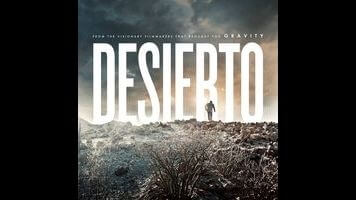Desierto looks to the border for B-movie thrills

In long shot, a pickup truck comes to a stop in a pale salt flat near the badlands. The horizon line is almost perfectly centered, so the frame is about half salted, dry mud and half sky. A cut brings us closer to the truck, on more or less the same axis with the horizon still centered, so that the landscape doesn’t appear to move at all. (Neat trick, that.) There are 12 passengers huddled in the back of the pickup, and three border smugglers up front, called coyotes in common parlance, though not here. The engine is dead, and one of the passengers, a mechanic who’s made the illegal crossing into the United States a few times before, baldly named Moises (Gael García Bernal), declares it unfixable. The smugglers negotiate among themselves. One will stay behind, while the other two will lead the group on foot to the U.S. border, through the badlands, where they will soon find themselves hunted by an American serial killer (Jeffrey Dean Morgan) who gets off on sniping would-be migrants with a bolt-action rifle.
One peculiarity of making a movie entirely outdoors in a desert is that every shot ends up looking like it has something to say; barren landscapes always suggest myth, because nothing else could survive somewhere so unforgiving. Director and co-writer Jonás Cuarón (son of Alfonso Cuarón) calls Desierto’s villain Sam, just to settle any doubt about what he’s supposed to represent. He rumbles across the terrain in his lifted Silverado, with a small Confederate Army flag flapping off the back and his beloved German shepherd, Tracker, in the passenger seat. From a high bleached rock, he begins to fire, cigarette still dangling from his lip, targets disoriented by echoes and the blinding midday sun. One could easily imagine Desierto as a lost exploitation film from the 1970s—better made than most, but not an exceptional example. The basics are all there: a detour, an unfriendly local, lengths taken to survive, blood and guts, the occasional shock of a bullet hitting a body out of nowhere.
Call it “bordersploitation.” As in so many of those scratched-up B films of eras past, what matters is the cultural anxiety exploited to fulfill the movie’s quota of cheap thrills. Cuarón’s visual style leans on wide-angle lenses to wrap the sweaty, bloodied survivors and their psychopathic pursuer in vast remote, ragged space; the scale of the badlands is much clearer than their geography, which gets confused by the continually changing direction of the chase. Everyone might as well be nameless, since they have nothing to say to each other beyond the perfunctory. All they have are gut feelings: survival instinct, deep-seated hate. But as Moises leads a dwindling handful of survivors over rocks and down narrowing ravines, they enact an allegory of migration, lost on their way to the promised land and hunted by a madman who doesn’t manifest cross-border tension so much as represent everything scary about the more violent fantasies of American isolation.